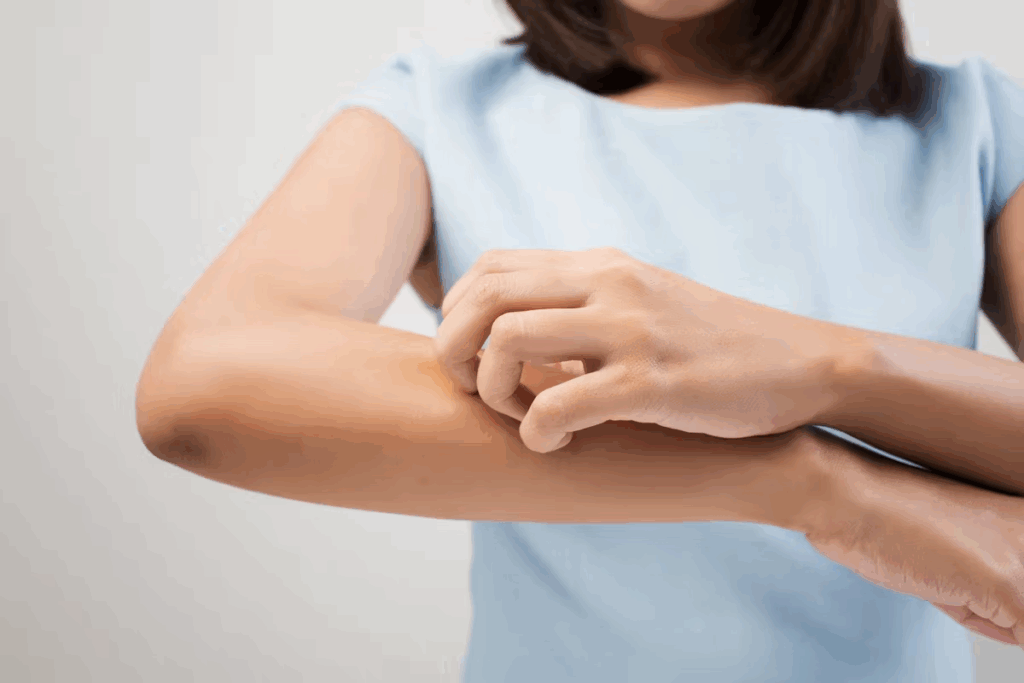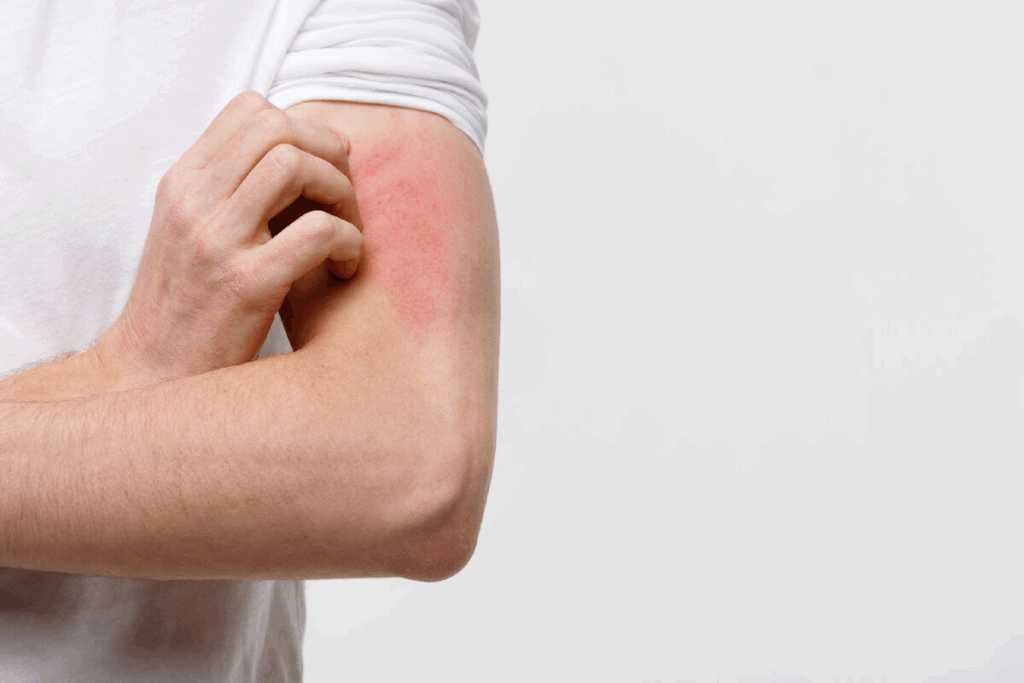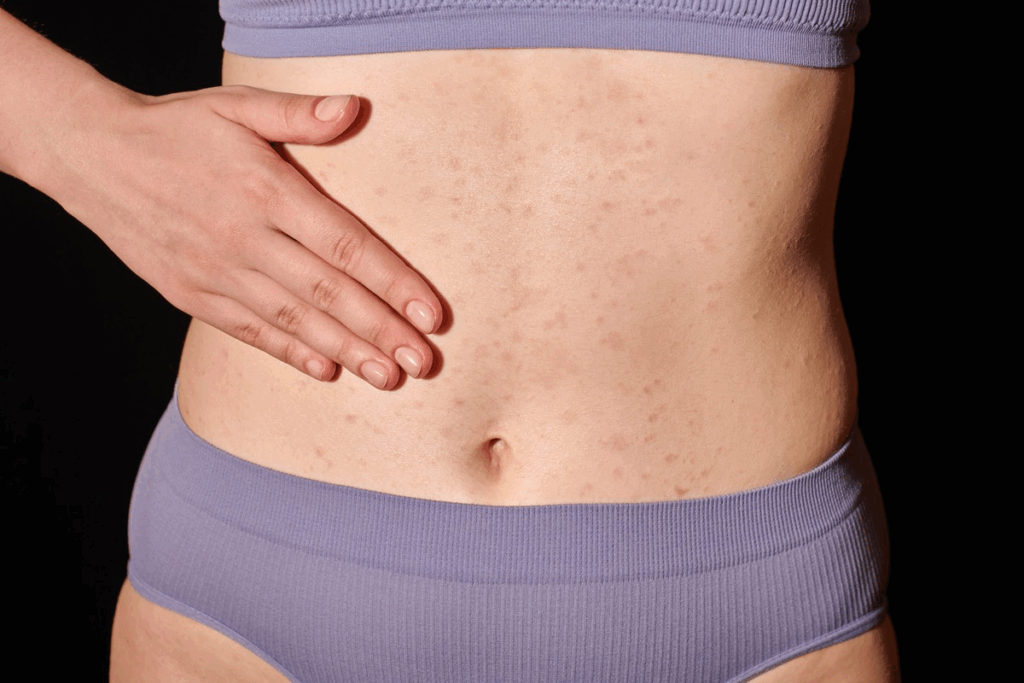
At Liv Hospital, we know how worried parents get when they see unusual skin rashes on their kids. Some rashes can be a sign of serious health issues, like acute lymphoblastic leukemia. It’s important for parents to know the signs and get help if they see anything odd. Learn leukemia rash child pictures, symptoms, and signs for early identification of pediatric blood cancer.
Leukemia rashes can look like tiny red or purple spots, called petechiae or purpura. These spots don’t fade when you press on them. They often show up on the legs, arms, chest, or belly. Spotting these signs early is key to getting the right treatment fast.

Leukemia, a blood cancer, can show up in different ways on the skin. This worries parents and doctors a lot. We’ll look at how leukemia affects the skin, why it shows up in kids, and why catching it early is key.
Leukemia can lead to skin symptoms because it messes with blood cell production. This weakens the immune system, making the skin more prone to issues like petechiae, purpura, and leukemia cutis. Medical News Today says it’s important to know these skin changes for early diagnosis and treatment.
The skin symptoms of leukemia happen when cancer cells get into the skin or when the body reacts to the disease. For example, petechiae are small spots on the skin from tiny blood vessel breaks.
In kids with leukemia, skin symptoms are common and can be an early sign. The abnormal white blood cells from leukemia can get into the skin, causing different rashes and lesions.
These skin changes come from several reasons, like cancer cells directly getting into the skin, bleeding problems, and the body’s immune reaction to the cancer. Spotting these signs early can greatly help manage and treat the disease.
Finding leukemia early is key for good treatment and better survival chances. Skin symptoms can be an early sign, making parents seek medical help. Early diagnosis means starting treatment sooner, which can lessen symptoms and improve results.
| Skin Manifestation | Description | Significance |
| Petechiae | Small, pinpoint red spots | Indicative of minor hemorrhages |
| Purpura | Purple patches or bruise-like lesions | Signifies bleeding under the skin |
| Leukemia Cutis | Raised skin lesions or nodules | Direct infiltration of leukemia cells into the skin |
Knowing the signs of leukemia on the skin is vital for parents and doctors. Spotting these signs early helps get medical help fast. This can lead to better treatment results for kids with leukemia.

Leukemia rashes can be an early warning sign of blood cancer in children. It’s important to know what to look for. Leukemia often shows up through skin symptoms, so parents need to be aware of the signs.
When checking your child for leukemia rashes, look for unusual skin changes. Look for petechiae (small, pinpoint spots), purpura (larger purple patches), or leukemia cutis (raised lesions). These can show up on the legs, arms, chest, and abdomen.
Leukemia rashes can appear almost anywhere on the body. They often show up on the extremities, torso, and face. It’s key to watch your child’s skin, even more so if there’s a family history of leukemia or other cancers.
| Body Region | Common Leukemia Rash Manifestations |
| Legs and Arms | Petechiae, purpura, and leukemia cutis |
| Chest and Abdomen | Petechiae and purpura |
| Face | Purpura and leukemia cutis |
If you see any unusual skin changes, document them well. Take clear, well-lit photos of the rashes from different angles. Also, note the date and time of each observation. This will help doctors diagnose and monitor the condition better.
Petechiae are small, non-blanching spots on the skin that can be a sign of leukemia. They are tiny red or purple spots caused by minor bleeding from broken blood vessels. While they can be caused by many things, seeing them often means someone might have leukemia.
Petechiae linked to leukemia look different. They:
It’s important to know if these spots are petechiae or something else. If you’re not sure, it’s best to talk to a doctor.
Petechiae from leukemia can show up anywhere but often follow certain patterns. They often appear:
Photos of petechiae can help doctors diagnose leukemia. They show how the spots are spread, their size, and how they change over time. These pictures help doctors see how serious the condition is and if treatments are working.
In summary, petechiae are important signs that can point to leukemia. Knowing what they look like, where they show up, and what photos can show is key for catching and treating the disease early.
Purpura shows up as purple patches and bruise-like spots on the skin. It’s a big sign that can mean you have leukemia. Knowing about purpura and its link to leukemia helps catch it early.
The leukemia purpura rash looks like big, purple bruises on the skin. These spots can be different sizes and might not hurt when you touch them. This rash happens because of low platelet counts or when platelets don’t work right.
In the early stages of leukemia, purpura rash starts small and grows. At first, you might see tiny spots that get bigger and more. The rash gets worse in places that get hit or pressed a lot. Watching how the rash grows is key to figuring out what’s causing it.
Leukemia purpura shows up in many places, but it’s most common on arms and legs. It can also be seen on the chest and other areas. Where the purpura appears can help doctors understand if it’s linked to leukemia.
| Characteristics | Description |
| Appearance | Large, purple patches resembling bruises |
| Cause | Low platelet counts or platelet dysfunction |
| Common Locations | Arms, legs, trunk |
Leukemia can show up on the skin as raised nodules. This is called leukemia cutis. It happens when leukemia cells get into the skin, making visible spots or nodules. These spots can show how far the disease has spread.
Leukemia cutis nodules can look different. They are usually firm, painless, and might be red or purple. You can find them on any part of the body but often on the face, arms, and legs. Spotting them early is key for treatment.
Leukemia cutis can show up in many ways and places. It often appears on the face, around the eyes and nose, and on the arms and legs. The spots can be small or big. Watching for any skin changes is very important.
“The presence of leukemia cutis can be an important diagnostic clue, as it often indicates the presence of underlying leukemia.”
Photos can help doctors spot leukemia cutis. They show how the spots change over time. Keeping track of these changes is vital for diagnosis and tracking the disease.
Knowing what leukemia cutis looks like helps both patients and doctors. It makes it easier to spot and manage the condition.
Leukemia rash on the legs and extremities can be an early warning sign of the disease. It’s important to understand the patterns and characteristics of these rashes to aid in early detection.
The appearance of leukemia rash on the legs can vary. It often shows up as petechiae or purpura. Petechiae are small, pinpoint spots from broken capillary blood vessels. Purpura are larger patches that look like bruises.
Medical experts say, “The presence of petechiae or purpura on the legs and extremities should prompt further investigation for leukemia. This is true if accompanied by other symptoms like fatigue or unexplained weight loss.”
At first, leukemia rash may show up as isolated spots on the legs. Over time, these spots can coalesce into larger clusters, forming more pronounced lesions. Watching how these rashes progress is vital for understanding the disease’s advancement.
While leukemia rash can appear anywhere, it often shows up on the lower extremities first. The legs, in particular, are a common site for early-stage leukemia rashes. Spotting the early signs on the legs can help with timely medical intervention.
We recommend being vigilant about any unusual skin changes. This is true if they are accompanied by other concerning symptoms. Early detection and diagnosis are critical in managing leukemia effectively.
Knowing about acute lymphoblastic leukemia rash is key for early detection. ALL is a blood and bone marrow cancer. It shows up in different skin rashes.
ALL skin signs can differ, but often include petechiae, purpura, and leukemia cutis. Petechiae are small, pinpoint spots from tiny capillary bleeding. Purpura are bigger bruise-like patches. Leukemia cutis has leukemia cells in the skin, causing raised lesions.
These rashes look different from other skin issues. For example, leukemia cutis shows up as firm, painless nodules or plaques.
| Characteristic | Description |
| Petechiae | Small, pinpoint red or purple spots due to minor hemorrhages |
| Purpura | Larger, bruise-like lesions resulting from bleeding under the skin |
| Leukemia Cutis | Raised, firm nodules or plaques due to leukemic cell infiltration |
When ALL rashes show up can differ. Some have them at diagnosis, others later.
ALL rashes can pop up anywhere but often on arms, legs, face, and chest. Where and how they look can hint at the diagnosis.
Understanding ALL rash traits, timing, and spots helps doctors diagnose better. This leads to better treatment plans.
Children with leukemia may get itchy skin rashes for several reasons. It’s important to know why and how to handle these symptoms. This helps in giving them the best care possible.
Leukemia can make the skin itch because of chemicals from leukemia cells. These chemicals cause inflammation and itching.
Other reasons for itching in leukemia patients include:
Leukemia patients might itch and bruise at the same time. Bruising happens because of low platelet counts, a common problem in leukemia.
To manage both symptoms, we need a detailed plan. This includes:
| Symptom | Management Strategy |
| Itching | Moisturizing creams, antihistamines |
| Bruising | Platelet transfusions, avoiding injuries |
Managing skin issues in kids with leukemia needs a team effort. We use creams for itching, protect against bruising, and take care of their skin overall.
“The key to managing skin symptoms in leukemia is early detection and intervention. By understanding the causes and implementing appropriate care strategies, we can significantly improve the quality of life for these children.”
We suggest regular check-ups with doctors to adjust treatment plans as needed.
Hives can be scary, and they might not always be just an allergy. Sometimes, they can be a sign of leukemia. Hives, or urticaria, are a common skin reaction. They can happen for many reasons, including allergies. But, in some cases, they might mean something serious like leukemia.
Hives linked to leukemia are different from those caused by allergies. For example, leukemia hives might last longer and be bigger. They might also come with other signs like fever or weight loss. Knowing these differences is key to figuring out if hives could mean leukemia.
Telling allergic hives from leukemia rashes is important for the right treatment. Allergic hives are itchy, red, and can pop up anywhere. They usually get better with antihistamines or corticosteroids. But, leukemia rashes might not itch, spread out more, and not get better with usual treatments.
| Characteristics | Allergic Hives | Leukemia Rashes |
| Itchiness | Commonly itchy | Often not itchy |
| Response to Treatment | Typically respond to antihistamines or corticosteroids | May not respond to typical allergic reaction treatments |
| Associated Symptoms | Usually isolated to skin symptoms | Often accompanied by systemic symptoms like fever or weight loss |
How long hives last and how they react to treatment can tell us a lot. Allergic hives usually go away in a few days with the right treatment. But, hives from leukemia might stick around or keep coming back. They also don’t get better with usual allergy treatments.
Knowing the difference between allergic hives and those from leukemia helps catch problems early. If you’re worried about hives or any skin changes, see a doctor right away.
Leukemia can show up in many ways on the skin, not just the usual ones. These less common signs are important for catching leukemia early and treating it right.
Leukemia can make gums and the inside of the mouth swell and bleed. Kids might show these signs first, like swollen gums or mouth ulcers.
“Gingival infiltration by leukemic cells can result in significant gum enlargement, often accompanied by bleeding and discomfort,” as noted in medical literature. Spotting these signs early is key to catching leukemia fast.
Leukemia can cause scary-looking rashes on a child’s face. These might look like red patches or purple spots. They can look like other common childhood rashes.
It’s important to tell these rashes apart from harmless ones. A close look and tests are needed to figure out what’s causing them.
Leukemia can also cause rare skin issues like leukemia cutis. This is when cancer cells get into the skin, making bumps or lesions. These can pop up anywhere on the body and might come with other symptoms.
Another rare sign is Sweet syndrome. It’s marked by fever, high white blood cell count, and sore, red skin. Spotting these rare signs is critical for diagnosing and treating leukemia.
Knowing about these less common leukemia skin rashes helps doctors diagnose and treat patients better.
It’s important to tell leukemia rashes apart from other common skin issues in kids. Leukemia rashes can look like many harmless conditions. So, knowing the differences is key for parents and doctors.
Viral exanthems are rashes from viruses. They can look like leukemia rashes. But, they usually come with fever, cough, or sore throat. They also go away in a few days.
Leukemia rashes, on the other hand, last longer. They often come with tiredness, losing weight, or pain in bones.
“The presence of systemic symptoms can be a critical differentiator between leukemia rashes and viral exanthems.”
Looking at pictures of leukemia rashes and benign conditions can show clear differences. Leukemia rashes are often small spots, larger purple patches, or raised bumps. Benign conditions might look like hives, eczema, or other common skin issues.
For example, leukemia spots are usually all over and don’t get better with allergy treatments.
Leukemia rashes look, last, and come with symptoms that are different from common skin issues. They often stick around and come with fever, tiredness, or swollen lymph nodes. Benign rashes are usually short-lived and can get better with usual treatments.
“Early recognition of the differences between leukemia rashes and benign skin conditions can lead to timely diagnosis and treatment.”
Understanding these differences helps parents and doctors make better choices about when to get more medical help.
It’s important to know the signs of leukemia early. A rash can be a first sign of the disease. We’ve talked about different kinds of leukemia rashes and how they show up in kids.
If your child keeps getting sick, has a low fever, or looks pale, see a doctor. These signs, along with leukemia symptoms like swollen organs, mean they need a check-up. A doctor will do tests like a CBC and blood smear.
Getting medical help fast can really help kids with leukemia. We urge parents to watch for any unusual rashes or symptoms. If you’re worried about your child’s health, talk to a doctor.
Children with leukemia may show rashes like petechiae, purpura, or leukemia cutis. These rashes often pop up on the legs, trunk, or face. They are early signs of blood cancer and need quick medical care.
Leukemia can lead to skin issues like rashes, lesions, and bruising. This happens because of abnormal blood cells and leukemia cells in the skin.
Petechiae are tiny red spots from minor bleeding. Purpura are bigger, purple spots or bruises. Both can signal leukemia.
Leukemia rashes can show up on the legs, trunk, face, and other parts. They might also appear on the gums or inside the mouth.
Yes, leukemia can lead to itchy skin rash and bruising. The itching comes from leukemia cells in the skin or chemical releases.
Allergic hives are itchy, fleeting, and raised. Leukemia rashes are persistent, painful, and may come with fever, fatigue, or weight loss.
Less common leukemia skin rash signs include gum and mouth changes, facial rashes, and rare skin changes like leukemia cutis.
Leukemia rashes have unique signs like petechiae or purpura and often come with fever or fatigue. Common childhood skin issues are usually harmless and go away on their own.
If you see unusual or lasting rashes, with symptoms like fever, fatigue, or weight loss, get medical help fast. This is to check for leukemia or other serious conditions.
Yes, keeping records of skin changes, like photos and descriptions, helps doctors diagnose leukemia and track its progress.
Subscribe to our e-newsletter to stay informed about the latest innovations in the world of health and exclusive offers!
WhatsApp us